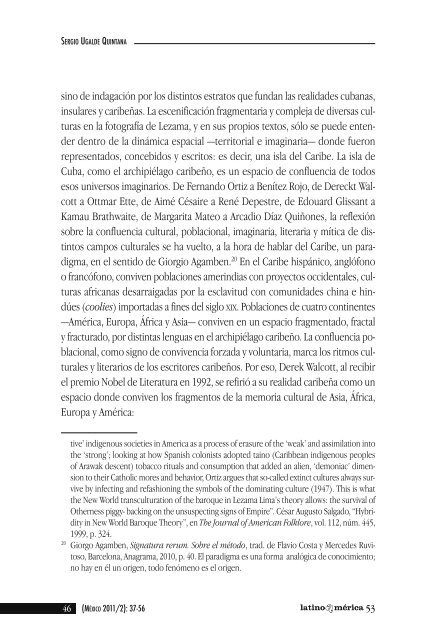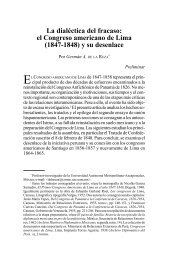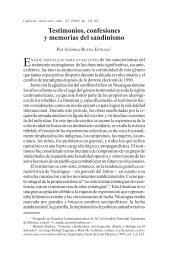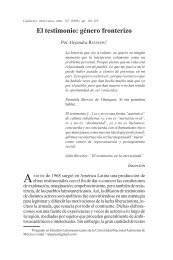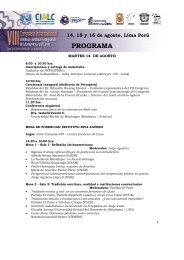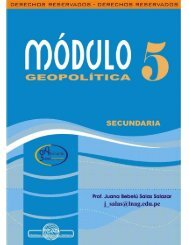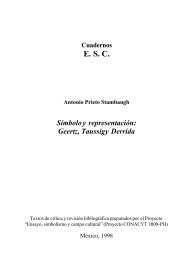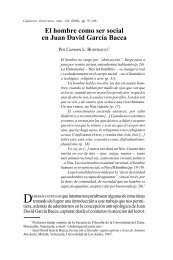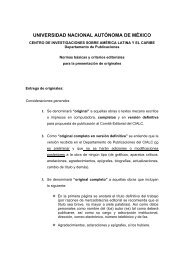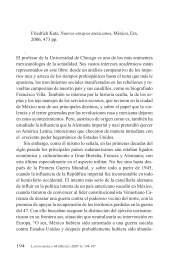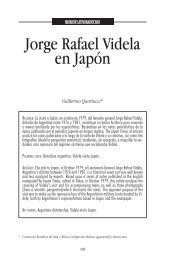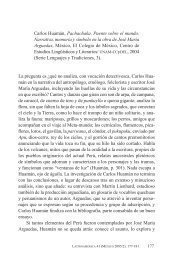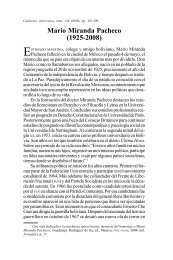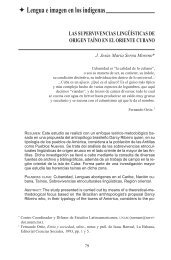Barroco y cultura afrocubana: Lezama y un saber de convivencia
Barroco y cultura afrocubana: Lezama y un saber de convivencia
Barroco y cultura afrocubana: Lezama y un saber de convivencia
You also want an ePaper? Increase the reach of your titles
YUMPU automatically turns print PDFs into web optimized ePapers that Google loves.
SERGIO UGALDE QUINTANAsino <strong>de</strong> indagación por los distintos estratos que f<strong>un</strong>dan las realida<strong>de</strong>s cubanas,insulares y caribeñas. La escenificación fragmentaria y compleja <strong>de</strong> diversas <strong>cultura</strong>sen la fotografía <strong>de</strong> <strong>Lezama</strong>, y en sus propios textos, sólo se pue<strong>de</strong> enten<strong>de</strong>r<strong>de</strong>ntro <strong>de</strong> la dinámica espacial —territorial e imaginaria— don<strong>de</strong> fueronrepresentados, concebidos y escritos: es <strong>de</strong>cir, <strong>un</strong>a isla <strong>de</strong>l Caribe. La isla <strong>de</strong>Cuba, como el archipiélago caribeño, es <strong>un</strong> espacio <strong>de</strong> confluencia <strong>de</strong> todosesos <strong>un</strong>iversos imaginarios. De Fernando Ortiz a Benítez Rojo, <strong>de</strong> Dereckt Walcotta Ottmar Ette, <strong>de</strong> Aimé Césaire a René Depestre, <strong>de</strong> Edouard Glissant aKamau Brathwaite, <strong>de</strong> Margarita Mateo a Arcadio Díaz Quiñones, la reflexiónsobre la confluencia <strong>cultura</strong>l, poblacional, imaginaria, literaria y mítica <strong>de</strong> distintoscampos <strong>cultura</strong>les se ha vuelto, a la hora <strong>de</strong> hablar <strong>de</strong>l Caribe, <strong>un</strong> paradigma,en el sentido <strong>de</strong> Giorgio Agamben. 20 En el Caribe hispánico, anglófonoo francófono, conviven poblaciones amerindias con proyectos occi<strong>de</strong>ntales, <strong>cultura</strong>safricanas <strong>de</strong>sarraigadas por la esclavitud con com<strong>un</strong>ida<strong>de</strong>s china e hindúes(coolies) importadas a fines <strong>de</strong>l siglo XIX. Poblaciones <strong>de</strong> cuatro continentes—América, Europa, África y Asia— conviven en <strong>un</strong> espacio fragmentado, fractaly fracturado, por distintas lenguas en el archipiélago caribeño. La confluencia poblacional,como signo <strong>de</strong> <strong>convivencia</strong> forzada y vol<strong>un</strong>taria, marca los ritmos <strong>cultura</strong>lesy literarios <strong>de</strong> los escritores caribeños. Por eso, Derek Walcott, al recibirel premio Nobel <strong>de</strong> Literatura en 1992, se refirió a su realidad caribeña como <strong>un</strong>espacio don<strong>de</strong> conviven los fragmentos <strong>de</strong> la memoria <strong>cultura</strong>l <strong>de</strong> Asia, África,Europa y América:tive’ indigenous societies in America as a process of erasure of the ‘weak’ and assimilation intothe ‘strong’; looking at how Spanish colonists adopted taino (Caribbean indigenous peoplesof Arawak <strong>de</strong>scent) tobacco rituals and consumption that ad<strong>de</strong>d an alien, ‘<strong>de</strong>moniac’ dimensionto their Catholic mores and behavior, Ortiz argues that so-called extinct cultures always surviveby infecting and refashioning the symbols of the dominating culture (1947). This is whatthe New World trans<strong>cultura</strong>tion of the baroque in <strong>Lezama</strong> Lima’s theory allows: the survival ofOtherness piggy- backing on the <strong>un</strong>suspecting signs of Empire”. César Augusto Salgado, “Hybridityin New World Baroque Theory”, en The Journal of American Folklore, vol. 112, núm. 445,1999, p. 324.20Giorgo Agamben, Signatura rerum. Sobre el método, trad. <strong>de</strong> Flavio Costa y Merce<strong>de</strong>s Ruvitoso,Barcelona, Anagrama, 2010, p. 40. El paradigma es <strong>un</strong>a forma analógica <strong>de</strong> conocimiento;no hay en él <strong>un</strong> origen, todo fenómeno es el origen.46 (MÉXICO 2011/2): 37-5653


